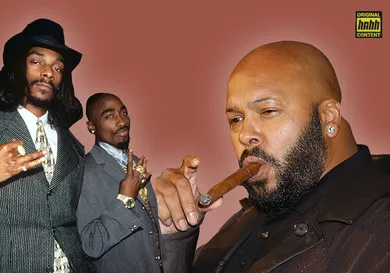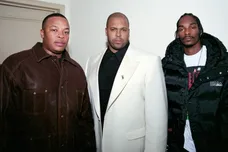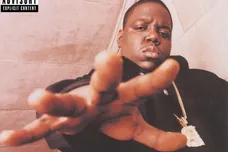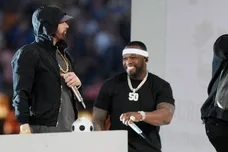We're highlighting this feature again today, in light of Michael "Harry-O" Harris' presidential pardon on January 19. Catch up on Death Row's history below.
The rise and fall of Death Row Records reads like a Greek epic, its larger-than-life characters and violent undercurrents the stuff of legend. It’s a cautionary tale that speaks to the spoils of war and the dangers that unfold when money and power begin to stifle the music. At a time when the commercial pop-rap of Marky Mark and the Funky Bunch, Tone-Loc, and MC Hammer was dominating mainstream outlets, Death Row transformed hardcore rap into an international phenomenon. A bastion of west coast gangsta rap, Death Row didn’t just sell “thug life” records; it sold a lifestyle.
The music coming out of Compton in the late ‘80s forever altered the course of hip hop, both artistically and politically. No one was more pivotal to this transformation than N.W.A., the seminal rap group that America had come to love and loathe. At its helm was Dr. Dre, the producer who engineered the direction of the group’s foul-mouthed and antagonistic debut Straight Outta Compton, a record that shoved aside radio play to connect with the streets. Cries of public morality from naysayers were squashed beneath lyrics that detailed the violence, drugs, sex, and police brutality of South Central Los Angeles to the tune of hundreds of thousands of record sales.
Suge Knight smoking a cigar, 2002 - Gregg DeGuire/WireImage/Getty Images
It’s the oldest story in the book: N.W.A. was raking in the cash, but the artists behind the music weren’t getting appropriately paid. Amid financial disputes and tired of labels ripping off black writers and performers, Dr. Dre and his partner, The D.O.C., decided to break out of the cycle of exploitation. Enter rap music mogul Marion “Suge” Knight, an imposing 350-pound brute once called “the most feared man in hip hop.” A music biz tough guy and rap’s most notorious boogeyman, the Big Bad Wolf with a cigar had gotten his start in the industry working as a bodyguard for Bobby Brown before landing a position as D.O.C.’s manager. Vowing to make it “the Motown of the ‘90s,” Knight co-founded Death Row Records with Dre and D.O.C. after strong-arming their contracts from Eazy-E’s Ruthless Records (Eazy would later claim in a lawsuit that Knight and his posse threatened him with lead pipes and baseball bats). Tasked with handling “business” affairs, Knight flexed his ability to extract royalties owed to black artists from record labels and white artists. Vanilla Ice claims that Knight threatened to throw him off a hotel balcony if he didn’t sign over royalties that he supposedly lifted from one of Knight’s associates. If the story is to be believed, then Death Row was in part funded by the extortion of the man responsible for “Ice Ice Baby.”
Assisted by SOLAR Records owner Dick Griffey, who offered the fledgling label an office and a studio in Hollywood, the Death Row enterprise had a space but desperately needed an infusion of cash. The money would come from Michael “Harry-O” Harris, one of LA’s biggest cocaine kingpins who legitimized his entrepreneurial image through various means, including producing Broadway play “Checkmates,” which gave Denzel Washington his start on the big stage. At the time, Harris was imprisoned on drug and attempted murder charges, so it fell to his lawyer David Kenner, a top-flight attorney with Hollywood connections, to broker a deal with Knight. With the guidance of Kenner, and with Knight overseeing negotiations, Harris invested $1.5 million as a silent partner in Death Row for a 50% share. The public “springing” of the partnership occurred at a label rollout party hosted at famous Beverly Hills restaurant Chasen’s. As if foreshadowing the mayhem that was to come, the invitations were printed to resemble subpoenas. Parent company Godfather Entertainment was born, and Death Row finally had a stake in the game.
Snoop Dogg and Dr. Dre performing at The Brixton Academy in London, Britain, 1994 - Brian Rasic/Getty Images
Interscope, an LA-based outfit run by Ted Field and Jimmy Iovine that was on the verge of going under, recognized the profits that could come from betting on music that made Tipper Gore’s blood boil and decided to distribute Dre’s long-awaited solo debut. The Chronic did not disappoint, becoming a multi-platinum milestone that would define the G-funk sound and scope of everything thereafter. Protégé Snoop Doggy Dogg’s Doggystyle debut, and the next four Death Row albums after it, garnered platinum-plus status. The militant politics and profoundly explicit lyrics, a reflection of the “post-Reaganomics, crack-cocaine era that transformed South Central Los Angeles into a 1980s war zone,” made Death Row an inescapable cultural fixture. Its league of emcees, invigorated by newcomers such as Nate Dogg, Tha Dogg Pound, RBX, The Outlawz, Kurupt, and The Lady of Rage, eschewed the more lyrical style of the East Coast for music that was wholly uncompromising in its directness.
The label’s crown jewel came in the form of Tupac Shakur, who was bailed out of a New York City jail where he was serving time for a sexual abuse conviction by none other than Knight. He promptly signed a multi-album deal with Death Row on a piece of “toilet paper,” and would go on to release All Eyez On Me, the first double album in rap and one of the fastest-selling rap albums in history. Songs like “California Love” and “2 of Amerikaz Most Wanted” were a testament to the undeniable chemistry of Death Row’s nucleus of Dre, Snoop, and Tupac, a trio that produced some of the most unforgettable and groundbreaking music of the ‘90s while under the watchful eye of Knight. With the three hitmakers all under contract, Death Row became “the greatest collection of superstar hip-hop talent on one label simultaneously”
Snoop Dogg and Tupac at the MTV Video Music Awards, 1996 - Kevin Mazur Archive/WireImage/Getty Images
Death Row’s four horsemen, “hip hop’s ferocious first family,” were featured on VIBE’s February 1996 cover in a Goodfellas-inspired collage that was both telling of the times and the label’s ultimate downfall. The names on the plaques that kept pouring in were all accompanied by rap sheets, further bolstering the myth of Death Row. Snoop Dogg’s murder trial, in which he was acquitted of first- and second-degree murder, was still in progress when the cover hit shelves. Ken Nahoum, Death Row’s in-house photographer, recalls that Tupac and Knight wore ankle bracelets to the shoot. “They all had issues. It was a wild scene. It wasn’t record company business as usual. These were gangsters on the run.”
In its prime, the awe-inspiring Death Row empire and its “all hits no bullshit” roster were near untouchable. It seems almost unfathomable that a label pulling in over $100 million a year would sink to its knees in such a startling fashion. In the end, the fleeting moment of dominance, captured on that 1996 cover, was followed by a bloody plummet to destruction. “Anything you said about them being threatening or violent or dangerous was more power to them,” said Alan Light, then editor-in-chief of VIBE. “There was just no way that all of that energy and madness could hold for very long.”
The earliest signs of trouble reared their ugly head at the 1995 Source Awards, where the $100,000 set for the Death Row roster received a less than lukewarm reaction from the NYC crowd. All it took was one comment from Knight pertaining to Bad Boy CEO Puff Daddy and the battlefield was set: “Any artist out there that wanna be an artist, stay a star, and won’t have to worry about the executive producer trying to be all in the videos, all on the records, dancing— come to Death Row!” The infamous remarks were the first major barrage in what would become a lethal war of words; the East Coast-West Coast rivalry that had been bubbling ever since Tupac had been shot and robbed in a hotel lobby in 1994 suddenly became a firestorm. “Hit ‘Em Up" confirmed the feud in magnificent fashion, with the aforementioned emcee hurling ferocious insults at Bad Boy and its own star, The Notorious B.I.G.
Behind the scenes, more malignant cracks were beginning to form in the Death Row foundation. The waters had become choppy, and the sharks were swarming: the Death Row studios had become a breeding ground for Knight’s cronies, made up of gang members and off-duty LAPD officers later implicated in the Rampart Scandal The profit-hungry Knight, emboldened by his entourage, began to exert tighter control of the label’s roster, as his unorthodox business practices increasingly began to mirror the violent themes of the music. Snoop Dogg described the situation at the studio as “everybody being in a chokehold.” As Death Row’s rebellious appeal increased, so too did its bloody aura. By the time anyone realized that Knight and Kenner had betrayed their former business partners, it was far too late. The progressively more vicious infighting was the final straw, and in March 1996, Dre split from Death Row to create Aftermath, his own imprint under Interscope. With the golden touch of Dre no longer a part of Death Row’s stable, all hell broke loose.
Tupac and Snoop Dogg at the 23rd Annual American Music Awards, 1996 - Ke.Mazur/WireImage/Getty Images
On September 7, 1996, six months after Dre’s departure, Tupac was gunned down at a red light in Las Vegas while sitting in the passenger seat of Knight’s BMW 750iL. He survived in critical condition for six days before eventually succumbing to his injuries. Just three hours prior to the shooting, Knight had gotten into a scuffle with known Southside Compton Crip Orlando Anderson, who would later become the prime suspect in Tupac’s murder case. The fight was caught on surveillance camera at the MGM Grand Hotel, and the footage was used to charge Knight with a parole violation worth a 9-year sentence.
50 Cent, Eminem and Dr. Dre at the launch of Shade 45, 2004 - Frank Micelotta/Getty Images
With its reign of terror officially at a close, the kill or be killed mentality that Death Row embodied had proven to be entirely too controversial and volatile. Knight now sits rotting in a cell for a fatal hit-and-run incident, his fine line of persuasion a relic of Death Row’s heyday. Tupac’s memory lives on through a fabled discography that includes countless posthumous releases that have only reinforced his martyr status as hip hop’s patron saint. Snoop has sustained relevancy through his savvy willingness to branch out into ventures that include everything from youth football to a cooking show with Martha Stewart. And Dre is a billionaire businessman, one of the most successful that the entertainment industry has ever seen. Iconic music aside, without the triumphs and defeats of both N.W.A. and Death Row Records, there would be no Aftermath. And without Aftermath, there would be no Eminem or 50 Cent or perhaps even a Beats By Dre, the cultural goldmine headphone company that was sold to Apple in a landmark deal worth $3.2 billion. It’s a historical progression that has had implications far beyond Death Row’s four-year run from December 1992, when Dre’s debut hit stores, to September 13, 1996, when a surgeon at the United Medical Hospital in Las Vegas pronounced Tupac Shakur dead.
In hindsight, the shelf life of a company plagued by gross mismanagement, manipulation, and violence was never going to be substantial, let alone sustainable. The ink black haze of the 1996 VIBE cover, now in focus through the lens of past tragedies, offers a stark reminder of this reality: “Get in. Get out. And hopefully leave with your life and dignity intact. Very few leave with both...Two did. Two didn’t.”







